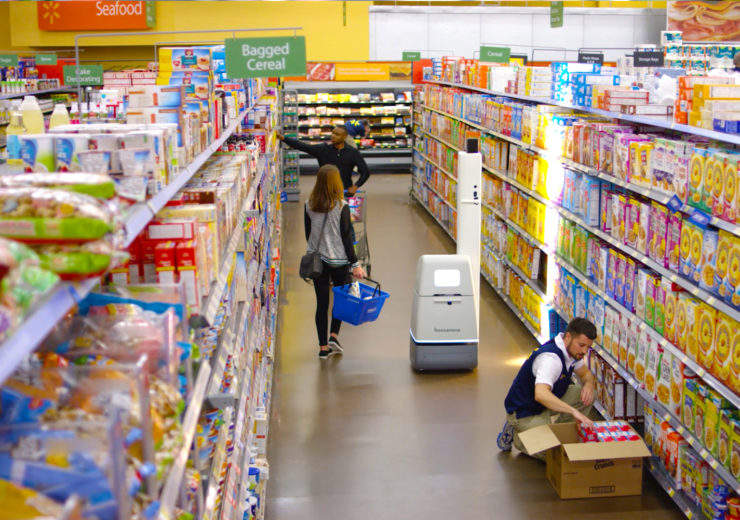From robots helping shelf-stackers to recommendation engines, AI in shopping is becoming more prevalent - but retail remains behind many other industries when it comes to artificial intelligence adoption, as Dan Robinson found at Teradata Analytics Universe 2018

Bossa Nova robots roam supermarket aisles to scan shelves and collect data on stock
From predicting your next purchase to the best times of day for stacking shelves, there are a wide range of use cases for AI in shopping.
Amazon is already king for recommending products based on searches and previous purchases, but industry experts at the Teradata Analytics Universe 2018 technology conference in Las Vegas believe machine learning and deep learning offer many more opportunities.
AI in shopping use cases
Michael Halula, senior business consultant at Teradata, highlighted the frustration customers feel when they buy a product from a retailer and then get an email a few days later recommending they purchase the same thing.
Instead, he believes more retailers should look at using AI to create a “personalised shopper” experience.
He said: “The retailer needs to understand why you’re buying something. I’m not going to send them a coupon for tables and chairs if they’ve just bought a set.

“Instead, I might send suggestions for an umbrella or seat cushions for the chairs.
“We can go further than that, too, and predict preferences. Are they a brand consumer?
“Do they like to be really seamless and know exactly what they want to buy or do they want recommendations?
“That algorithm should get smarter and learn your preferences every time you buy something.”
AI in shopping extends to predictive shelf-stacking
For staff, stock replenishment can be made more efficient using predictive analytics.
Mr Halula pointed to the shelf-stacking robots built by US tech start-up Bossa Nova and deployed by Walmart.
Roaming down supermarket aisles, the robots report on items missing from shelves by scanning them, and can detect objects in an aisle, such as boxes, trolleys and people, to avoid bumping into them.

Australian company Black.ai, which won $1.2m (£900,000) in investment earlier this month, has also developed AI technology that maps a store in real-time with 3D sensors in the ceiling to track what customers do and do not pick up.
The system uses this information to figure out if a customer has tried to dupe a self-service scanner in some way.
Mr Halula said: “How can I adjust the replenishment cycles in-store? Back in the day, I’d have 10 to 12 people in the store doing that.
“Now I have six people but can I make it more efficient? AI will help with that.
“It logs when the best times are to restock according to their popularity with customers by using predictive modelling.”
But retail industry is slow to adopt AI in shopping
While the potential of AI in shopping is clear, retail lags behind many other industries when it comes to adopting artificial intelligence, claims Chad Meley, who is responsible for Teradata’s AI and deep learning products.
The vice-president of marketing told Compelo: “The most penetrated industries we’re seeing right now are financial services, manufacturing and telecoms.
“There’s a lot of interest in healthcare, too, but we haven’t got to the point where we can say ‘this is working’, even though we have quite a big order book.

“But retail seems to be lagging compared to the rest. In e-tailing, there’s good opportunities as you can see from what Amazon has done with AI and increasing the percentage of revenue that comes from recommendation engines. People in retail are taking notice of that.
“We’re also starting to think about traditional retailers with bricks and mortar can benefit by using cameras to work out how people move around a store and optimise that.
“There’s not a lack of opportunity, it’s just a matter of fact that from our point of view, they’re slower to embrace AI.”
The industries that are embracing AI
Mr Meley said many industries are moving away from basic statistics and are now looking at deep learning, which teaches computers to do what comes naturally to humans, such as learn by example.
He added: “There’s this conception that AI is more for digital giants like Google and Amazon but it can be for anyone no matter which industry you’re in – healthcare, financial services, insurance, retail or manufacturing for example.
“Increasingly, you should be asking yourself ‘could deep learning and other AI branches help my business?’
“We’ve helped manufacturers with yield operations. If you just get a small increase in operational effectiveness, it’s worth a lot of money. AI can be used to better predict when maintenance will be needed.
“Multiple banks are using it for fraud detection, whereas they’ve traditionally used light analytics.

“There’s a lot of hype and scepticism but the key is to start having conversations about what’s achievable with AI now and what the business opportunities are.”
Talent is an issue, though, and businesses are having to find ways of plugging the gap between what they are doing and what’s required for deep learning.
Mr Meley added: “A lot of companies are now incubating through professional services. It’s hard to attract talent right now because they get gobbled up by Google and other tech giants.”


